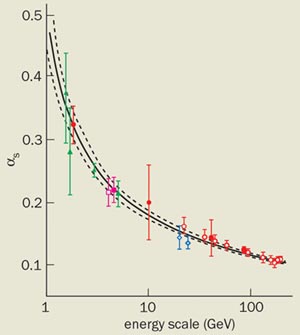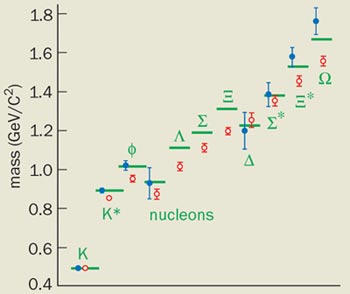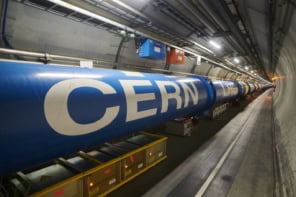Pentaquarks do not fit into the traditional quark model of hadrons, but understanding these exotic new particles is offering fresh insights into the subtleties of the strong interaction
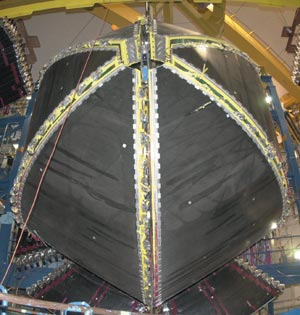
In the early 1960s particle physicists found that they had wandered into a jungle. They were confronted by a bewildering array of particles called hadrons that did not appear to follow any discernible pattern. Murray Gell-Mann eventually tamed this hadronic jungle by proposing that all hadrons are made up of combinations of more fundamental particles called quarks: mesons contain a quark and an antiquark, while baryons contain three quarks. Some physicists found this bold hypothesis difficult to swallow at first, but for four decades these two basic “body plans” have been more or less adequate to accommodate the many new hadrons that have turned up in experiments.
Now, however, we are finding that the closely tended garden of hadrons is abloom with exotic new growths. Last year, researchers working on the LEPS experiment at the SPring-8 laboratory in Japan announced the discovery of a new particle called the θ+(1540) that does not conform to either the meson or baryon body plan (figure 1). Physicists have speculated about such particles – for which the “1540” represents the mass of the particle in MeV – from time to time. In fact, the possibility of an exotic particle with such a mass was suggested by Dmitri Diakonov and colleagues at the Petersburg Nuclear Physics Institute in 1997, although this was based on a rather different view of hadrons from the one described here.
The LEPS result was quickly confirmed by other experiments, including the CLAS experiment at the Jefferson lab in Virginia and the DIANA experiment at the ITEP lab in Moscow. Soon afterwards, the NA49 collaboration at CERN found evidence for a family of heavier particles that appear to be close relatives of the θ+, and this March the H1 collaboration at the DESY laboratory in Hamburg caught a glimpse of what could be a more exotic cousin of the new particle.
The fundamental properties of these particles and the way in which they form are not known. Indeed, there is still debate about whether they exist at all. One popular interpretation is that the new particles contain four quarks and one antiquark in a bound state. Whether or not this picture turns out to be correct, coming to terms with the possibility of such “pentaquarks” is offering exciting new insights into the subtleties of the strong interaction.
An exotic challenge
Everyone agrees that the fundamental theory of the strong interaction is a quantum field theory known as quantum chromodynamics, or QCD for short. QCD is remarkable theory in a variety of ways. Firstly, it consistently embodies both special relativity and quantum mechanics. Quantum electrodynamics (QED), and its expansion to the electroweak Standard Model of particle physics, is also a quantum field theory. However, QED is known to break down and develop inconsistencies at short distances. The quantum field theory of gravity that we obtain from general relativity also suffers from a similar complaint, in an even more virulent form. QCD is unique in that it does not suffer from this problem, and as such it forms our most logically perfect theory of nature.
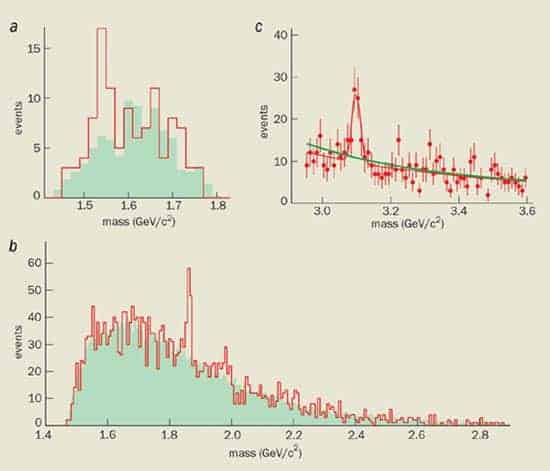
QCD is also a beautiful theory. Its equations possess an extraordinary degree of symmetry called colour gauge invariance that fixes their structure quite precisely. As a consequence, QCD is extremely well defined: quarks interact with gluons, and gluons interact with each other in a fixed pattern (see Further information). A very small number of parameters, namely one universal coupling strength and one mass for each kind of quark, specify QCD completely. One cannot change the equations in any way without spoiling their symmetry, and ultimately their consistency. This means that the quantitative predictions of QCD, which in principle cover all the phenomena of the strong interaction, are unambiguous: no fudge factors are available.
On the empirical side, QCD has earned our confidence by surviving thousands of rigorous tests. For example, the results of different kinds of experiments involving hundreds of independent measurements can all be interpreted consistently within QCD using only the parameter that describes the strength of the interaction (figure 2). Another notable success of QCD is the prediction of “asymptotic freedom”, which means that the coupling strength between quarks and gluons should decrease at high energies or, equivalently, short distances. This is in stark contrast to the coupling strength in QED, which gets larger at short distances.
So what is the problem? Quite simply, the equations of QCD are very difficult to solve. Their most striking consequence is that neither quarks nor gluons can appear in isolation: instead they are forever confined in hadrons such as protons and neutrons. This bizarre property of QCD involves complex and highly nonlinear dynamics. While there are circumstances in which we can make quantitative predictions directly from the fundamental theory, such as those shown in figure 2, there are also many physically important questions that cannot be answered this way.
To put it crudely, we can do a good job of predicting the properties of energetic quarks and gluons, and of the “jets” of hadrons that they leave behind. However, we find it difficult to describe the way that quarks and gluons bind together to form hadrons. We have a hard time calculating the masses and properties of familiar particles such as protons, neutrons and pions from first principles, and we have an even harder time with the many baryon and meson relatives of these particles. As for atomic nuclei, we have had no success at all in calculating their properties directly from the equations of QCD.
However, by exploiting the latest supercomputers, researchers have been able to calculate the masses of a few of the lightest and simplest strongly interacting particles (figure 3). These calculations provide us with profound insights into the origin of mass in matter. For example, protons and neutrons have masses of almost 1000 MeV, yet they are built from up quarks and down quarks that have a combined mass of about 20 MeV, and from gluons that have precisely zero mass! Unfortunately, however, the techniques employed in these calculations are specialized, fragile and hugely demanding in terms of computer power. They allow us to calculate a few quantities very accurately, but so far they are useless for most others.
This situation – a beautiful fundamental theory that is hard to work with – is quite common in science. Paul Dirac famously remarked that with the advent of quantum electrodynamics we had in our hands a theory that covered “all of chemistry, and most of physics”. There is some truth in this. In a few cases, such as the magnetic moment of the electron, we can calculate the predictions of QED to within a few parts per billion or less, and then compare these with experiments. The agreement is remarkable (see “Muons: particles of the moment”).
However, QED also has practical limitations. The fundamental coupling strength in the theory, α ~ 1/137, is weak, and this allows us to calculate the properties of simple atoms and molecules as a power series in a. We are therefore reasonably sure that we can write down equations that, if we were able to solve them, would describe the shape and stability of large molecules. But this is a big if. In practice, neither theoretical nor experimental chemistry has been replaced by supercomputers cranking away at the equations of QED. Instead, chemists have developed concepts such as chemical valence, and models such as the ball-and-stick picture of molecules. The relationship between these models and fundamental QED, however, is not entirely straightforward.
In QCD the challenge is even more daunting. There is no useful scheme of successive approximation, no starting place for an order-by-order attack on the structure of hadrons. The coupling strength that is analogous to α in QED is small at short distances, but it grows larger as we approach the distances at which hadrons form. The size of the proton, for example, is the distance at which the coupling strength between quarks becomes so large that their mutual attraction overcomes the natural tendency of quantum objects – which are described by waves – to spread out. If QCD theorists want to describe hadrons, they have to turn to models from the start.
The quark model
One famous and successful model, which actually predates QCD, is the quark model. As we mentioned earlier, this model was invented in response to the discovery in the 1960s of hundreds of very short-lived particles. The quark model postulates that the basic entities in the strong interaction are not the particles that we observe directly, but rather quarks and antiquarks. The observed particles are supposed to follow one of two basic “body plans”: mesons are assembled from a quark and an antiquark, denoted qq-bar, while baryons are assembled from three quarks, qqq.
These basic plans allow for several elaborations. Each quark can be chosen from any of six flavours: up, down, strange, charm, bottom and top. Furthermore, their spins can be aligned in various ways, and each quark can also be in different spatial orbitals. Each combination of quark flavours, for example, has a lowest energy state and a “tower” of higher-energy states, in much the same way that a particular atom has a ground state and various excited states. By making simple hypotheses for the masses of the quarks and their interactions, the quark model can account semi-quantitatively for the masses and properties of many hundreds of such higher-energy states, which are known as “resonances”.
The quark model thus succeeds in trimming a vast jungle of experimental material into a manageable garden, but its relation to fundamental QCD is loose at best. It does not provide the starting point for a systematic approximation to QCD, nor a reliable way to estimate the uncertainty in its predictions. However, QCD explains why individual quarks or gluons are not observed, because it allows only those body plans in which the number of quarks minus the number of antiquarks is equal to a multiple of three. The simplest possibilities are therefore qq-bar and qqq, which correspond to the mesons and baryons in the quark model, respectively.
This rule of three is a generalization of the concept of “opposite charges” that exists in QED: both the electron and the proton are electrically charged, but their charges are opposite so they can be combined to make a neutral state. In QCD the same principle holds: a quark and an antiquark can form a “colour neutral” state. Moreover, three quarks or three antiquarks can also make a neutral state. (One reason why the charge in QCD is called colour is that red, green and blue can be mixed together to make white.) At a deeper level, however, the more detailed assumptions of the quark model do not sit entirely comfortably within the concepts of QCD as a rigorous quantum field theory.
According to quantum field theory, gluons and pairs of light quarks and antiquarks should be spontaneously emitted and re-absorbed by the quarks and gluons inside hadrons. The body plans of the quark model gloss over this deeper structure, but it is definitely present. When we examine protons closely by bombarding them with electrons, we find that they contain plenty of gluons and light quark-antiquark pairs. In fact, they contain an infinite number. And even if we ignore these quantum fluctuations, and accept the “rule of three” for quark–antiquark combinations, we must wonder: why are exotic body plans such as tetraquarks (qqq-barq-bar) or pentaquarks (qqqqq-bar) not found in the spectrum of hadrons?
Another well known and highly successful model, which predates even the quark model and whose success partly explains why quarks took so long to discover, is the traditional model of atomic nuclei. In this model, nuclei are pictured as loose aggregates of nucleons (protons and neutrons) each of which, according to the quark model, has three quarks locked inside it. The success of this model forces us to add an epicycle to the quark model in which a practically unlimited number of bound states containing three-quark combinations is allowed. In other words, as well qqq states, we also have to allow (qqq)n states.
The traditional nuclear model forces us to ask what prevents two separate three-quark bags from merging to form a single six-quark bag? To answer this we first need to understand the origin of the strong repulsion between nucleons. This repulsion is of fundamental importance in conventional nuclear physics because it prevents mergers that would obliterate the identity of individual nucleons. In particular, we need to know why the H “dibaryon”, which has a quark composition of uuddss, is not observed. The straightforward quark-bag model suggests the H dibaryon ought to be relatively light, stable and easy to observe, but it has not been observed experimentally.
As this discussion makes clear, the issue of exotic hadrons exposes profound weaknesses in our current understanding of the strong interaction. Why do we not observe more particles that do not conform to the quark-model body plans? And if such “exotics” do exist, what form might we expect them to take? We believe that the answers to these questions lie in a careful consideration of the interaction between quarks. The traditional quark model treats interactions between quarks as an afterthought, or as a perturbation to be more precise. In QCD this is justified at high energies, or short distances, but not in general. Indeed, the fundamental equations of QCD suggest some rather specific properties of the quark interaction.
For instance, the force between two quarks is attractive when both the colours and the spins of each quark are different, or (more precisely) antisymmetric. When two quarks are correlated in this way they form an especially low-energy configuration, which we call a diquark. These correlations are strongest when they involve the light quarks (u, d and s), and are more prominent for u and d quarks than they are for s quarks. As a result, diquarks come in three varieties: [ud], [us], and [ds], where the square brackets reflect the antisymmetry of the quark wavefunctions.
Diquarks should not be considered as particles in their own right. Although they contain two quarks, they are not colour neutral and therefore cannot exist as isolated bound states. Instead they float around inside hadrons as composite entities with a size of about 1 fm, which is approximately the same size as the hadrons. Diquarks are thus conceptual building blocks, which give us a useful ordering principle for the most important states in the hadronic spectrum. A similar concept is familiar in chemistry: electrons with opposite spins like to form pairs, and it is often useful to think of paired electrons as loosely bound units inside atoms or molecules.
